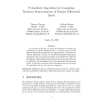Free Online Productivity Tools
i2Speak
i2Symbol
i2OCR
iTex2Img
iWeb2Print
iWeb2Shot
i2Type
iPdf2Split
iPdf2Merge
i2Bopomofo
i2Arabic
i2Style
i2Image
i2PDF
iLatex2Rtf
Sci2ools
AAECC
2008
Springer
2008
Springer
Probabilistic algorithms for computing resolvent representations of regular differential ideals
In a previous article [14], we proved the existence of resolvent representations for regular differential ideals. The present paper provides practical algorithms for computing such representations. We propose two different approaches. The first one uses differential characteristic decompositions whereas the second one proceeds by prolongation and algebraic elimination. Both constructions depend on the choice of a tuple over the differential base field and their success relies on the chosen tuple to be separating. The probabilistic aspect of the algorithms comes from this choice. To control it, we exhibit a family of tuples for which we can bound the probability that one of its element is separating.
| Added | 08 Dec 2010 |
| Updated | 08 Dec 2010 |
| Type | Journal |
| Year | 2008 |
| Where | AAECC |
| Authors | Thomas Cluzeau, Evelyne Hubert |
Comments (0)

